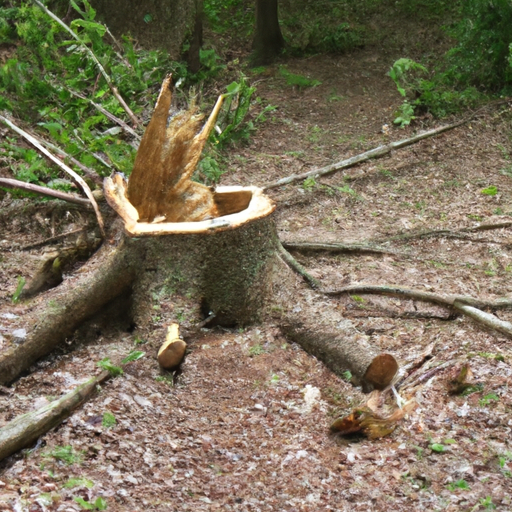
How Do You Get Rid Of Trees?
When it comes to tree removal, there are various considerations to take into account. Whether you’re dealing with a hazardous tree, a tree that’s interfering with your property, or simply want to create more space in your yard, understanding the process is crucial. In this article, we will guide you through the steps involved in tree removal, outlining the different factors to consider, legal and environmental considerations, the process of hiring professional services, and even do-it-yourself techniques. By the end, you’ll have a comprehensive understanding of how to effectively and safely get rid of trees.
Understanding the Need for Tree Removal
Identifying reasons for tree removal
Before embarking on the tree removal process, it’s important to identify the reasons behind your decision. Common reasons for tree removal include tree diseases, structural issues, root damage, interference with utility lines, overgrowth, and potential hazards. By understanding why you want to remove the tree, you can better evaluate the necessary steps and potential alternatives.
Evaluating the risks and benefits of tree removal
Tree removal can have both positive and negative impacts on your property. While it may provide more space, clear the view, or eliminate potential hazards, removing a tree can also impact the environment, reduce shade, and diminish the aesthetic appeal. It is essential to evaluate both the risks and benefits before proceeding.
Considering alternative solutions
Before resorting to tree removal, it’s worth considering alternative solutions. This may include pruning, trimming, or relocating the tree if feasible. Consulting with an arborist can help you explore alternative options that may be less invasive while still addressing your concerns.
Assessing Tree Removal Requirements
Determining the tree species and size
Identifying the tree species and its size is crucial in determining the best approach for removal. Different tree species have varying characteristics, such as root structure and density, which can impact the removal process. Additionally, the size of the tree will determine the complexity and equipment needed for removal.
Identifying potential obstacles
Before removing a tree, it’s important to identify any potential obstacles that may hinder the process. This includes nearby structures, power lines, fences, or other trees that may impede access to the target tree. Understanding these obstacles will help you plan accordingly and ensure safe and efficient removal.
Assessing the location and accessibility
The location of the tree plays a significant role in the tree removal process. Accessibility, proximity to structures or power lines, and available space for necessary equipment are all factors to consider. Assessing the location will allow you to determine the best approach for removing the tree and ensure the safety of both the workers and your property.
Evaluating the surrounding environment
When removing a tree, it’s important to consider the impact on the surrounding environment. This includes nearby vegetation, wildlife habitats, and soil erosion. Taking these factors into account will help you minimize the potential environmental impact and preserve the ecological balance.
Legal and Environmental Considerations
Checking local tree removal regulations
Before proceeding with tree removal, it’s essential to check local regulations and permits that may be required. Some areas have specific rules governing tree removal to protect their natural resources and maintain the aesthetic appeal of the community. Ensuring compliance with these regulations will help you avoid legal issues and potential fines.
Obtaining necessary permits
Depending on the size and location of the tree, you may need to obtain permits before removing it. Contact the local municipality or tree conservation organization to determine the requirements for your area. It’s important to ensure you have all the necessary documentation in place to proceed with the removal legally.
Considering environmental impact
While tree removal may seem like a straightforward task, it’s crucial to consider the potential environmental impact. Trees play a significant role in air purification, soil stabilization, and providing habitat for wildlife. By understanding the impact of tree removal on the environment, you can make more informed decisions and explore alternatives that minimize ecological disruption.
Exploring options for tree relocation
In some cases, relocating a tree may be a viable alternative to complete removal. Consult with an arborist to assess the feasibility of tree relocation based on the species, size, and health of the tree. Relocating a tree can help preserve its beauty and environmental benefits while addressing your concerns about its current location.

Hiring Professional Tree Removal Services
Researching and finding reputable tree removal companies
When considering professional tree removal services, it’s important to research and find reputable companies in your area. Seek recommendations from neighbors, friends, or local gardening associations to ensure you choose a reliable service provider. Look for companies with experience, proper licenses, and a track record of delivering quality results.
Requesting cost estimates and comparing quotes
To make an informed decision, it’s advisable to request cost estimates and compare quotes from multiple tree removal companies. This will ensure you have a clear understanding of the associated costs and allow you to choose a service provider that offers fair pricing. However, keep in mind that while price is essential, quality, experience, and safety should also be prioritized.
Verifying insurance and credentials
Before finalizing your decision, verify that the tree removal company has adequate insurance coverage. This will protect you from liabilities in case of accidents or property damage during the removal process. Additionally, ensure that the company’s staff are properly trained, certified, and equipped to carry out the removal safely.
Checking for customer reviews and recommendations
Customer reviews and recommendations can provide valuable insights into the quality and reliability of a tree removal service provider. Utilize online review platforms or ask for references from the company directly. Positive testimonials and recommendations indicate the company’s ability to deliver satisfactory outcomes and provide peace of mind.
Signing a detailed contract
Once you have selected a tree removal company, it is crucial to sign a detailed contract that outlines the scope of work, timeline, and agreed-upon price. Review the contract thoroughly and seek clarification on any unclear terms or conditions. Having a written agreement will protect both parties and ensure that expectations are met throughout the tree removal process.
DIY Tree Removal Techniques
Assessing personal skills and equipment
If you’re considering a do-it-yourself approach to tree removal, it’s important to assess your personal skills and the necessary equipment. Removing a tree can be physically demanding and requires specialized tools and knowledge. If you’re unsure, it may be safer to hire professional services.
Understanding basic tree removal steps
Tree removal involves various steps, including planning, preparing the site, tree felling, and stump removal. It’s crucial to understand these basic steps and the correct order in which to carry them out. Research and educate yourself on proper techniques to ensure a safe and successful removal.
Ensuring safety precautions and protective gear
Safety should be the primary concern when performing a DIY tree removal. Always wear appropriate protective gear, including a hard hat, safety goggles, gloves, and sturdy work boots. Adhere to safety guidelines and take precautions to minimize risks and potential injuries.
Cutting techniques for smaller trees
For smaller trees, manual cutting techniques can be employed. Use a chainsaw or handsaw to make an undercut, followed by a backcut to fell the tree in the desired direction. Research proper cutting techniques for the specific tree species and consult with an expert if needed.
Tackling tree removal challenges
Tree removal can present various challenges, such as limited space, nearby structures, or complicated tree structures. Assess each challenge individually and determine the most appropriate approach to overcome it safely. If you encounter obstacles beyond your abilities or expertise, it may be necessary to seek professional assistance to avoid potential risks.

Tree Removal Equipment
Essential tools for tree removal
Effective tree removal requires the use of specific tools designed for the task. Essential equipment includes chainsaws, handsaws, pruning shears, wood chippers, and safety gear. Depending on the size and complexity of the tree removal, additional equipment such as cranes, winches, and harnesses may also be necessary.
Understanding the purpose and use of each tool
Understanding the purpose and proper use of each tool is critical to ensure safe and efficient tree removal. Proper handling of tools, such as chainsaw maintenance, correct cutting techniques, and safety precautions, will help prevent accidents and ensure successful removal.
Safety guidelines for using tree removal equipment
Using tree removal equipment can be hazardous if not done correctly. Always follow safety guidelines provided by equipment manufacturers, such as wearing appropriate safety gear, proper handling, and maintenance. Ensure you are trained on the specific equipment you are using to minimize the risk of accidents.
Renting or purchasing necessary equipment
Depending on the frequency of tree removal and your personal circumstances, you may choose to rent or purchase necessary equipment. Renting equipment can be a cost-effective option for one-time or infrequent removals, while purchasing may be more beneficial for those who require regular tree maintenance. Consider your specific needs to determine the most suitable option.
Tree Stump Removal
Methods for tree stump removal
Removing a tree stump is often necessary after felling a tree. There are several methods available, each with its advantages and considerations. The two most common methods are chemical stump removal and using a stump grinder. Each method requires specific tools and techniques, so choose the one that aligns with your preferences and abilities.
Chemical stump removal
Chemical stump removal involves using chemicals to speed up the decomposition process of the stump. This method requires patience, as it can take several weeks or months for the stump to break down. Follow the instructions provided by the manufacturer and exercise caution when handling chemicals.
Using a stump grinder
Stump grinders are powerful machines specifically designed to grind tree stumps down to below ground level. This method is quick and efficient, but it requires specialized equipment and expertise to operate safely. Consider hiring a professional with experience in stump grinding if you are not confident in handling the machine yourself.
Manual removal techniques
If you prefer a more hands-on approach, manual tree stump removal techniques can be employed. This includes digging around the stump, exposing its roots, and using an ax or grub hoe to sever the roots. Manual removal is physically demanding and time-consuming, especially for larger stumps, so be prepared for the challenge.

Disposing of Removed Trees
Options for tree debris disposal
Once the trees are removed, you will need to consider the disposal of the resulting debris. There are several options available depending on the size of the debris and your preferences. The most common options include chipping and mulching, composting, or professional hauling services.
Composting tree waste
Composting is an environmentally friendly way to dispose of smaller tree waste. Branches, leaves, and smaller wood pieces can be shredded and added to a compost pile. Over time, the organic material will break down and can be used as nutrient-rich compost for your garden.
Recycling wood
If the removed trees yield larger pieces of wood, recycling is a sustainable option. Wood can be repurposed for various projects or donated to woodworking enthusiasts. Additionally, some recycling centers accept wood waste that can be used as fuel or transformed into other products.
Hiring professional hauling services
For larger tree removal projects or if you are unable to dispose of the debris yourself, hiring professional hauling services may be the most practical solution. These services will efficiently remove the tree debris, ensuring proper disposal or recycling. Research local hauling companies to find reliable and eco-conscious services.
Conclusion
Removing trees from your property is a significant undertaking that requires careful consideration and planning. Whether you choose to enlist the help of professional tree removal services or tackle the task yourself, it’s essential to assess the reasons for removal, evaluate your options, and ensure compliance with legal and environmental regulations. By following the guidelines outlined in this article, you will be equipped with the knowledge and understanding to effectively and safely get rid of trees while minimizing the impact on your property and the surrounding environment.

